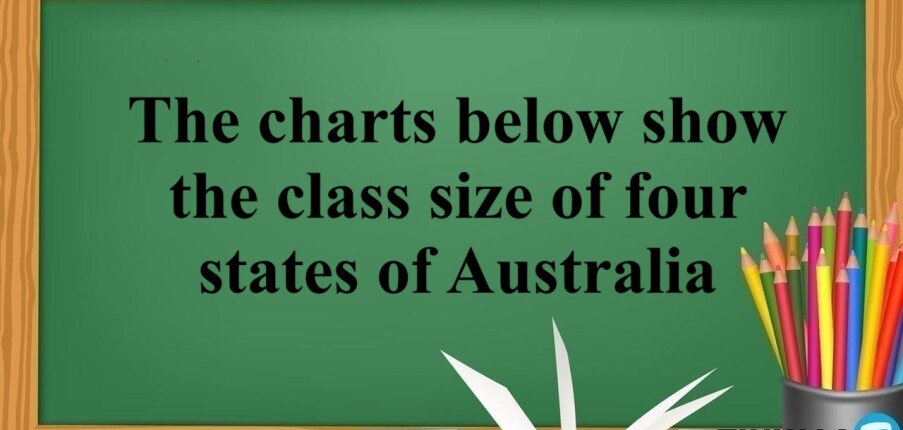The charts below show the class size of four states of Australia | Bài mẫu IELTS Writing Task 1
Phân tích biểu đồ
Dạng biểu đồ: Tròn (Pie charts)
Đặc điểm tổng quan:
- Nhìn chung, các lớp có 21-25 học sinh chiếm tỷ lệ lớn nhất ở cả bốn bang được khảo sát, ngoại trừ Nam Úc, nơi phổ biến nhất là các lớp có dưới 20 học sinh.
- Ngược lại, những lớp học có trên 29 học sinh là rất hiếm ở những khu vực này.
Sắp xếp thông tin:
Đoạn 1 - Mô tả và so sánh số liệu của New South Wales và South Australia.
- Ở New South Wales, 37% số lớp tiểu học ở bang này có 21-25 học sinh, theo sau là những lớp có 26-30 và ít hơn 20 học sinh (lần lượt là 33% và 26%).
- Trong khi đó, ở Nam Úc, tỷ lệ lớp học có dưới 31 học sinh dao động từ 28% đến 36%, trong đó phổ biến nhất là các lớp có tối đa 20 học sinh.
- Đáng chú ý, số liệu về quy mô lớp học lớn nhất ở cả hai bang đều như nhau, mỗi bang chỉ ở mức 4%.
Đoạn 2 - Mô tả và so sánh số liệu của Australia Capital Territory và Western Australia.
- Ở Lãnh thổ Thủ đô Australia, các lớp gồm 21-25 học sinh chiếm đa số, hơn một nửa số lớp được liệt kê, so với 38% số lớp có không quá 20 học sinh. Điều này hoàn toàn trái ngược với những lớp học có 26-30 học sinh, chiếm 1/10 tổng số, cao gấp 10 lần so với quy mô lớp học nhỏ nhất.
- Ở Tây Úc, quy mô lớp học chiếm ưu thế một lần nữa là 21-25 học sinh, chiếm 42%, trong khi có sự khác biệt không đáng kể ở tỷ lệ các lớp có dưới 20 và 26-30 học sinh, với con số lần lượt là 26% và 27%. Vị trí cuối cùng là lớp có quy mô lớn nhất vì tỷ lệ của nó chỉ là 5%.
Bài mẫu
Bài mẫu 1
The charts give a breakdown of class sizes in primary schools across four Australian regions in 2010.
Overall, classes having 21-25 students held the largest share in all four states surveyed, except for South Australia, where classes with under 20 students were most common. In contrast, classes containing over 29 students were a rarity in these areas.
Looking first at New South Wales, 37% of the primary-level classes in this state had 21-25 students, followed closely by those with 26-30 and fewer than 20 students (33% and 26% respectively). In South Australia, meanwhile, the percentages of classes comprising under 31 students ranged from 28% to 36%, with classes having a maximum of 20 students being the most popular. Notably, the figures for the biggest class size in both states were the same, each standing at only 4%.
Turning to Australia Capital Territory, classes consisting of 21-25 students constituted the majority, at just over half of all class sizes listed, compared to 38% of classes having no more than 20 students. This was in stark contrast to classes with 26-30 students, making up one-tenth of the total, ten times higher than the smallest class size. In Western Australia, the predominant class size was, again, 21-25 students, occupying 42%, while a negligible difference was observed in the proportions of classes with under 20 and 26-30 students, with figures of 26% and 27%, in that order. In the last position was the largest class size, as its share was only 5%.
Bài mẫu band 5.0+
The given pie charts demonstrate the size of classes in primary schools in four regions in Australia in 2010, they are: New South Wales, South Australia Australia Capital Territory and Western Australia.
Overall, the highest percentage has class with 21-25 students in Capital Territory of Australia and the least percentage was indicated also there, classroom with 30 pupils or more. The other states were illustrated almost similar proportions in the largest classroom.
According to the pie charts, it is obvious that New South Wales and Western Australia have same percentage in the smallest classroom which can contain 20 or even fewer students in primary schools, it is 26%. Four percent was shown in the piece of pie charts demonstrating the proportion of classes with 30 students or more. Australici Capital Territory has the highes proportion of classes containing 20 students or fewer, while New South Wales has almost same percentage of classes containing 21-25 stusents, it is 38% and 37%. The proportions of classes which contain 26-30 students are almost similar in Western and South Australia, just 27% and 28%.
Bài mẫu band 6.0+
The table and pie chart detail information concerning demographic situation in Australia regarding variety of ethnic groups and territories. Overall, it is readily apparent that the vast majority of ethnicities are Australians themselves. Regarding the location of nationalities most people's preference is to live in cities rather than in countrysides.
Concerning the percentages of population, Australian people are 73%, but less than 10% are Chinese,British and New Zealanders. However the smallest amount are Dutchiens 1%. The least common venue are other nationalities 14%.
In terms of the areas, urban place is the most preferable at the number of less than 99%,more precisely Chinese and New Zealanders around 90-99% of people living in cities and less than 10% in the countryside. Furthermore, there are 80% of Australians live in metropolis, which is 4 times higher than the number of individuals who live in villages. Finally, a similar trend can be seen in the proportion of British and Dutch, with more than 80% residing in the city and less than 20% staying in the countryside.
Bài mẫu band 7.0+
The charts compare class sizes of primary schools in different regions within Australia in 2010.
Overall, it can be seen that classes including 21 to 25 students were preferred over other scales in most of the states. In addition, having more than 30 students per class was the least favorable among all surveyed areas.
Regarding New South Wales and South Australia, in 2010, the class size of 21 to 25 pupils accounted for 37% and 33% correspondingly. Looking more closely at South Australia, classes with fewer than 20 students were shown to occupy the highest percentage, at 36%, while this scale took up 10% less than that in New South Wales. In comparison, 28% of primary classes in South Australia included 26 to 30 students whereas the figure for New South Wales on this scale was relatively high, at 33%.
At the same time, classes of 21 to 25 students were the most preferable in Australia Capital Territory and Western Australia as well, which made up for 51% and 42% respectively. Compared to this scale, the class size of under 20 pupils accounted for 38% in the capital region and 26% in the western state. Additionally, classes consisted of 26 to 30 students occupied 10% in the capital area whereas the proportion of Western Australia was 27%. Lastly, the class which had 30 pupils or above only took up 4% in New South Wales and the southern state, 5% in the west area and just 1% in the capital
Bài mẫu band 7.5+
The charts categorize classes in four Australian states based on the number of students attending.
Overall, classes consisting of over 30 students occupy the most modest proportions, while it is more common for classes in the mentioned states to have between 21 and 25 students than larger or smaller sizes.
The Australian Capital Territory is a representative of the two states with the most common class size (21–25 students), while the other is Western Australia, at figures of 51% and 43%, respectively. Classes with 20 students and below, as well as those with 26–30 students, display minor differences between these two states, at 20–25% for the former and 27–29% for the latter.
However, the majority of classes in New South Wales comprise fewer students, with up to 40% consisting of only 20 students and lower, although those with more students are not uncommon, at around 30% individually. Meanwhile, in South Australia, larger classes (26–30 students) account for up to 44%, compared to 23% of those with 21–25 students.
Finally, one salient feature that all four states share is that only a slight number of classes contain more than 30 students, at only 2–3%.
Bài mẫu band 8.0+
The pie charts compare sizes of classes in primary schools across four Australian states.
Overall, the majority of classes in nearly every state mentioned consisted of up to 25 students. While classes with 26-30 students were relatively common in New South Wales, Western Australia, and South Australia, such class sizes were rare in the Australian Capital Territory. Notably, larger classes – those more than 30 students – were almost nonexistent in all four states.
The majority of classes had no more than 25 students. In New South Wales and South Australia, this figure stood at about 70%, with classes of 21-25 students accounting for most of this amount (37% and 33%, respectively). Larger classes – 26-30 and more than 30 – made up the remaining percentages in both states.
A similar pattern can be observed in the remaining states – Australian Capital Territory and Western Australia. While a staggering 90% of classes in the former state were filled with students up to 25, it was slightly less in the latter state, at about 70%. The figure for classes with over 26 students stood at approximately 30%, three times the figure for Australian Capital Territory.
Phân tích từ vựng
- hold (v) the (definite article) largest (superlative adj) share (n)
hold: nắm giữ
the: cái
largest: lớn nhất
share: phần
Dịch nghĩa: nắm giữ phần lớn nhất
Cách sử dụng: "Hold the largest share" nghĩa là sở hữu hoặc kiểm soát phần lớn nhất trong một ngữ cảnh cụ thể, như thị trường hoặc nguồn lực.
Ví dụ minh họa: Apple Inc. holds the largest share of the smartphone market. (Công ty Apple Inc. nắm giữ phần lớn nhất trên thị trường điện thoại thông minh.)
- a (indefinite article) rarity (n)
a: một
rarity: sự hiếm có, sự hiếm thấy
Dịch nghĩa: một điều hiếm thấy, hiếm có
Cách sử dụng: "A rarity" là một điều hiếm thấy hoặc không phổ biến trong một ngữ cảnh cụ thể.
Ví dụ minh họa: In a world filled with digital books, finding someone who still reads printed novels is a rarity. (Trong một thế giới đầy sách điện tử, tìm thấy ai đó vẫn đọc tiểu thuyết in giấy là một điều hiếm thấy.)
- primary-level (adj) classes (n)
primary-level: ở mức trình độ cấp tiểu học
classes: các lớp học
Dịch nghĩa: các lớp học ở mức trình độ cấp tiểu học
Cách sử dụng: "Primary-level classes" là các lớp học dành cho học sinh ở mức trình độ cấp tiểu học, thường dành cho trẻ em từ độ tuổi 6 đến 12.
Ví dụ minh họa: Primary-level classes typically focus on foundational subjects such as reading, writing, and mathematics. (Các lớp học ở mức trình độ cấp tiểu học thường tập trung vào các môn học cơ bản như đọc, viết và toán học.)
- the (definite article) biggest (superlative adj) class (n) size (n)
the: cái
biggest: lớn nhất
class: lớp học
size: kích thước
Dịch nghĩa: kích thước lớp học lớn nhất
Cách sử dụng: "The biggest class size" là số lượng học sinh trong một lớp học lớn nhất trong một trường hoặc chương trình học cụ thể.
Ví dụ minh họa: The school had to hire an additional teacher because the biggest class size in the first grade was too large for one instructor to manage effectively. (Trường phải thuê thêm một giáo viên bởi vì kích thước lớp học lớn nhất ở lớp một quá lớn để một người hướng dẫn viên quản lý một cách hiệu quả.)
- the (definite article) majority (n)
the: cái
majority: đa số
Dịch nghĩa: đa số
Cách sử dụng: "The majority" đề cập đến phần lớn hoặc đa số của một nhóm, tập hợp, hoặc quần thể.
Ví dụ minh họa: The majority of the students in the class preferred studying in the library rather than at home. (Đa số học sinh trong lớp thích học tại thư viện thay vì ở nhà.)
stark: rõ rệt, đối lập
contrast: sự tương phản
Dịch nghĩa: sự tương phản rõ rệt
Cách sử dụng: "Stark contrast" là một cụm từ chỉ sự khác biệt hoặc tương phản rất lớn giữa hai điều hoặc tình huống khác nhau.
Ví dụ minh họa: There is a stark contrast between the bustling city during the day and the quiet, peaceful streets at night. (Có sự tương phản rõ rệt giữa thành phố sôi động vào ban ngày và các con phố yên bình, tĩnh lặng vào ban đêm.)
- a (indefinite article) negligible (adj) difference (n)
a: một
negligible: không đáng kể, rất nhỏ
difference: sự khác biệt
Dịch nghĩa: sự khác biệt không đáng kể
Cách sử dụng: "A negligible difference" đề cập đến một sự khác biệt hoặc biệt lệ rất nhỏ, thường không đủ quan trọng để được xem xét.
Ví dụ minh họa: The price increase was so small that it made a negligible difference in the monthly expenses. (Sự tăng giá quá nhỏ nên không tạo ra sự khác biệt đáng kể trong các chi phí hàng tháng.)
Xem thêm các tài liệu Tiếng Anh hay, chi tiết khác:
TOP Việc làm "HOT" dành cho sinh viên:



